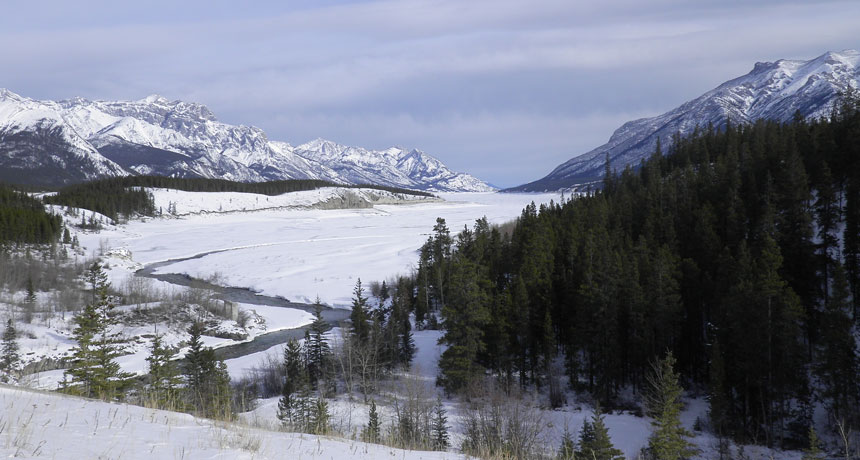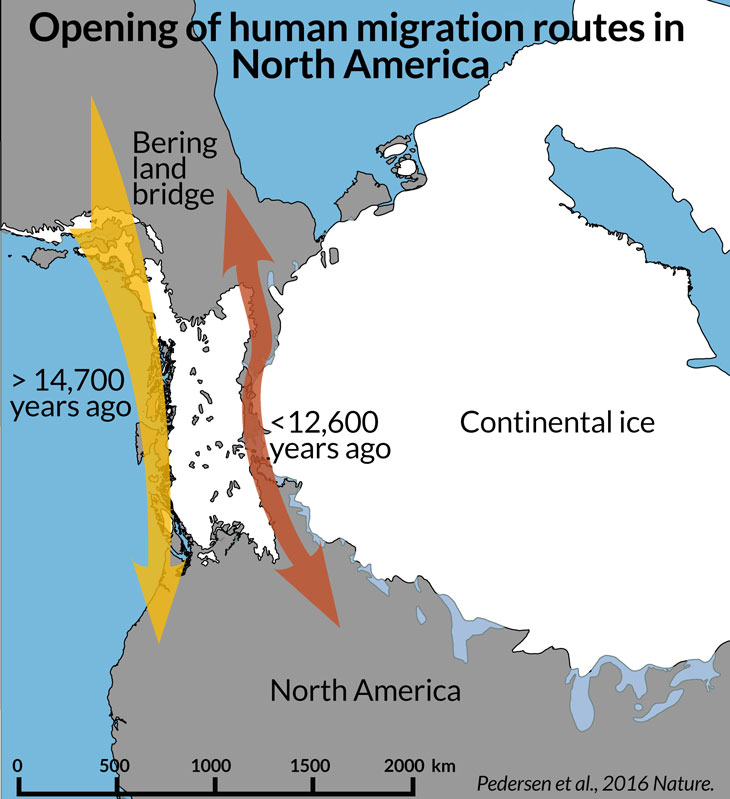Humans may have taken different path into Americas than thought
Arctic passage wouldn’t have provided enough food for the earliest Americans’ journey

BARREN LANDSCAPE A passage between the colossal glaciers that once covered the North American Arctic, shown here in present day, may have contained too little vegetation and wildlife to nourish the earliest human migrations into the rest of the Americas.
M.W. Pedersen/University of Copenhagen
The first American pioneers could not have reached the New World the way most textbooks say they did, researchers conclude in a new study. An open corridor through the ice-covered North American Arctic was too barren to support human migrations before around 12,600 years ago, fossilized DNA evidence suggests.
“If you look at a textbook about the earliest people in the Americas, you’ll see an arrow going from Siberia, into Alaska and through this interior ice-free corridor,” says study coauthor Eske Willerslev, an evolutionary geneticist at the University of Copenhagen. “This whole schoolbook example of how the Americas were populated seems to fall apart.”
By analyzing DNA embedded inside ancient lakebeds, Willerslev and colleagues reconstructed the ecological history of a segment of the passage. Though it was ice-free during the earliest human migrations — dating back at least 14,700 years — for thousands of years, the passage contained too little vegetation and wildlife to feed the travelers, the researchers conclude in the Aug. 10 Nature. The findings, which have drawn skepticism from other experts who say the researchers overlooked other evidence, support the idea that the first Americans instead traveled down the coast.
When the first humans trekked across the Bering Strait land bridge from Siberia, they encountered a land jam-packed with towering glaciers. Some dauntless groups, such as the forerunners of the Clovis people, may have somehow navigated this icy realm potentially as early as around 20,000 years ago (SN: 2/16/08, p. 102). Geologic evidence suggests that an opening appeared between two retreating ice sheets around 15,000 to 14,000 years ago, making an inland journey much easier.
For decades, scientists assumed that this was probably the main migration route for early Americans. But at 1,500 kilometers, nearly the distance from Los Angeles to Seattle, the corridor was too long to traverse without a local ecosystem for sustenance.
Willerslev and colleagues analyzed nine sediment cores from western Canadian lakes along the corridor’s halfway point, which was the last segment to open. DNA fragments left over from the remains of plants and animals that once inhabited the area had accumulated in the muddy layers of the lakebeds. The team analyzed the DNA fragments and compared them with the genetic blueprints for known plants and animals.
Before around 12,700 years ago, the passage was sparsely populated with grassy plants, the team found. By 12,600 years ago, grass covered the land and supported populations of mammoth and bison. As time went on, trees grew and elk moved in. The forests eventually thickened, new tree species took root and moose appeared. While the passage wasn’t viable for the earliest human migrations, later groups could have used the corridor and lived off the land, Willerslev says. Earlier migrations may have instead followed the coastline, an idea previously proposed by other researchers, though confirming that alternative route will be tough. Much of the ancient coast has been swallowed by sea level rise, Willerslev says.
Some experts aren’t so sure about excluding the interior corridor for the earliest migrations. Humans may have traversed the corridor even when plants and animals were sparse, says Gary Haynes, an archaeologist at the University of Nevada, Reno. Humans had long hunted waterfowl in Siberia and could have followed and lived off the southward migrating birds. The method used by Willerslev and colleagues would not have detected waterfowl DNA. “You don’t have to have a comfortable ecosystem to have human beings exploring,” Haynes adds.
Other evidence doesn’t match with the new findings either, says Stuart Fiedel, an archaeologist at the Louis Berger Group in Richmond, Va. For instance, in a 2014 paper, researchers showed that elk migrated south from the Arctic by 13,100 years ago, well before the new work suggests that the corridor was crossable. But coastal caves don’t contain any elk remains, which would be expected if the elk followed the coast instead of the inland corridor, he says. “As to putting a kibosh on the idea that Clovis ancestors came through a corridor route,” Fiedel says, “I think they’re really off base.”








